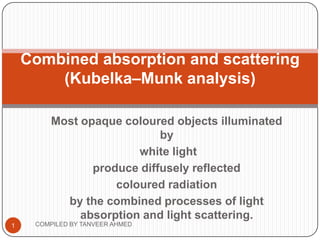
1.85 combined absorption and scattering (kubelka–munk analysis)
- 1. Combined absorption and scattering (Kubelka–Munk analysis) Most opaque coloured objects illuminated by white light produce diffusely reflected coloured radiation by the combined processes of light absorption and light scattering. 1 COMPILED BY TANVEER AHMED
- 2. Kubelka–Munk analysis Consider the simple case of a light beam passing vertically through a very thin pigmented layer of thickness dx in a paint film (Figure 1.28). We consider separately the downward (incident) and upward (reflected) components of the incident light beam, assuming that the absorption coefficient is represented by K and the COMPILED BY TANVEER AHMED scattering 2 coefficient by S.
- 3. At the same time, the The downward flux (intensity I) upward flux (intensity J) is: is: – decreased by absorption = – decreased by absorption = – – kJ dx KI dx – decreased by scattering = – decreased by scattering = – – SJ dx SI dx – increased by backscatter = – increased by backscatter = + + SI dx (from the radiation SJ dx (from the radiation proceeding downward), proceeding upwards, of which J summarised by Eqn 1.21: is the intensity), which is summarised by Eqn 1.20: 3 COMPILED BY TANVEER AHMED
- 4. Kubelka–Munk analysis Solution of these differential equations depends on the boundary conditions applied, but in the absence of scattering (S = 0) leads to the Lambert–Bouguer law for the downward flux. 4 COMPILED BY TANVEER AHMED
- 5. Kubelka–Munk analysis For an iso-tropically absorbing and scattering layer of infinite thickness (or at least so thick that the background layer reflection is negligible), it leads to the widely used Kubelka–Munk expression (Eqn 1.22): where R∞ = Jo/Io is the reflection factor at the surface for a sample of infinite thickness. 5 COMPILED BY TANVEER AHMED
- 6. Kubelka–Munk analysis The K, S and K/S values provide the colour technologist with functions which, in principle, are additive And linearly related to concentration of dyes and pigments in solid substrates. For example, for a dyed substrate where the scattering is attributed entirely to the textile substrate and therefore does not vary with dye concentration [D], we have a particularly simple form of concentration dependence (Eqn 1.23): 6 COMPILED BY TANVEER AHMED
- 7. Kubelka–Munk analysis where Kf and Kd are the light absorption coefficients for the fibre and dye respectively, at the wavelength of measurement, and Sf is the scattering coefficient of the fibre at the same wavelength. dye concentration [D], 7 COMPILED BY TANVEER AHMED
- 8. Kubelka–Munk analysis Limitation Although this relationship has certain limitations (for example, when dealing with highly exhausting acid dyes on wool and when taking measurements near the wavelength of maximum absorption), good linearity is observed (Figure 1.29; the raw data from which this plot is derived is shown in 8 Figure 1.31). COMPILED BY TANVEER AHMED
- 9. Kubelka–Munk analysis MAJOR Limitation Some of the major limitations to the Kubelka–Munk type of analysis are that it deals with diffuse monochromatic radiation and handles only two fluxes (diffuse light travelling upwards or downwards) through a homogeneous absorbing and scattering medium. The light loss through edges is thus neglected, as are the surface and the totally internally reflected components of the incident light beam. Other assumptions such as the uniform distribution of the dyes or pigments, and the lack of interactions between them, are also not realised. Such factors lead to a nonlinearity of the Kubelka–Munk function when measured over wide concentration 9 COMPILED BY TANVEER AHMED ranges.
